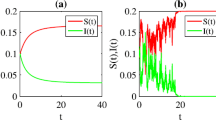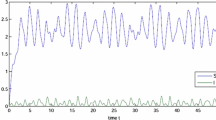Abstract
This paper aims to establish a novel explicit method for the stochastic SIS epidemic model, which can preserve the bounded positive domain and asymptotic properties. The proposed new method is based on combining a logarithmic transformation with a truncated Euler-Maruyama method, and it has the first-order rate of convergence for the pth-moment with \(p>0\). Moreover, without additional restriction conditions except those necessary to guarantee the extinction of the exact solution, the approximation of the extinction is achieved for the stochastic SIS model whose coefficients violate the global monotonicity condition. Some numerical experiments are given to illustrate the theoretical results and testify to the efficiency of our algorithm.








Similar content being viewed by others
Data Availability
Not applicable.
References
Alfonsi, A.: On the discretization schemes for the CIR (and Bessel squared) processes. Monte. Carlo. Methods. Appl. 11(4), 355–384 (2005). https://doi.org/10.1163/156939605777438569
Anderson, R., May, R.: Infectious Diseases of Humans: Dynamics and Control. Oxford University Press, New York (1992)
Brauer, F.: Mathematical epidemiology: past, present, and future. Infect Dis Model 2(2), 113–127 (2017). https://doi.org/10.1016/j.idm.2017.02.001
Capasso, V., Serio, G.: A generalization of the Kermack-McKendrick deterministic epidemic model. Math. Biosci. 42(1–2), 43–61 (1978). https://doi.org/10.1016/0025-5564(78)90006-8
Chen, L., Gan, S., Wang, X.: First order strong convergence of an explicit scheme for the stochastic SIS epidemic model. J. Comput. Appl. Math. 392:Paper No. 113482, 16 (2021). https://doi.org/10.1016/j.cam.2021.113482
Gray, A., Greenhalgh, D., Hu, L., et al.: A stochastic differential equation SIS epidemic model. SIAM. J. Appl. Math. 71(3), 876–902 (2011). https://doi.org/10.1137/10081856X
Gray, A., Greenhalgh, D., Mao, X., et al.: The SIS epidemic model with Markovian switching. J. Math. Anal. Appl. 394(2), 496–516 (2012). https://doi.org/10.1016/j.jmaa.2012.05.029
Hethcote, H.W., Yorke, J.A.: Gonorrhea Transmission Dynamics and Control. Springer-Verlag, Berlin (1984)
Hutzenthaler, M., Jentzen, A.: Numerical approximations of stochastic differential equations with non-globally Lipschitz continuous coefficients. Mem. Amer. Math. Soc. 236(1112), v+99 (2015). https://doi.org/10.1090/memo/1112
Hutzenthaler, M., Jentzen, A., Kloeden, P.E.: Strong and weak divergence in finite time of Euler’s method for stochastic differential equations with non-globally Lipschitz continuous coefficients. Proc. R. Soc. Lond. Ser. A. Math. Phys. Eng. Sci. 467(2130), 1563–1576 (2011). https://doi.org/10.1098/rspa.2010.0348
Hutzenthaler, M., Jentzen, A., Kloeden, P.E.: Strong convergence of an explicit numerical method for SDEs with nonglobally Lipschitz continuous coefficients. Ann. Appl. Probab. 22(4), 1611–1641 (2012). https://doi.org/10.1214/11-AAP803
Hutzenthaler, M., Jentzen, A., Wang, X.: Exponential integrability properties of numerical approximation processes for nonlinear stochastic differential equations. Math. Comp. 87(311), 1353–1413 (2018). https://doi.org/10.1090/mcom/3146
Jing, X., Liu, G., Jin, Z.: Stochastic dynamics of an SIS epidemic on networks. J. Math. Biol. 84(50), 1–26 (2022). https://doi.org/10.1007/s00285-022-01754-y
Kermack, W., McKendrick, A.: A contribution to the mathematical theory of epidemics. Proc. R. Soc. A. 115(772), 700–721 (1927). https://doi.org/10.1098/rspa.1927.0118
Li, X., Yang, H.: Explicit numerical approximation for logistic models with regime switching in finite and infinite horizons. 1–62 (2021). arXiv:2106.03540
Li, X., Ma, Q., Yang, H., et al.: The numerical invariant measure of stochastic differential equations with Markovian switching. SIAM. J. Numer. Anal. 56(3), 1435–1455 (2018). https://doi.org/10.1137/17M1143927
Li, X., Mao, X., Yin, G.: Explicit numerical approximations for stochastic differential equations in finite and infinite horizons: truncation methods, convergence in \(p\)th moment and stability. IMA J Numer Anal 39(2), 847–892 (2019). https://doi.org/10.1093/imanum/dry015
Li, X., Mao, X., Yang, H.: Strong convergence and asymptotic stability of explicit numerical schemes for nonlinear stochastic differential equations. Math. Comp. 90(332), 2827–2872 (2021). https://doi.org/10.1090/mcom/3661
Liu, W., Mao, X.: Strong convergence of the stopped Euler-Maruyama method for nonlinear stochastic differential equations. Appl. Math. Comput. 223, 389–400 (2013). https://doi.org/10.1016/j.amc.2013.08.023
Mao, X.: Stochastic Differential Equations and Applications, 2nd edn. Horwood Publishing Limited, Cambridge (2008)
Mao, X.: The truncated Euler-Maruyama method for stochastic differential equations. J. Comput. Appl. Math. 290, 370–384 (2015). https://doi.org/10.1016/j.cam.2015.06.002
Mao, X., Szpruch, L.: Strong convergence and stability of implicit numerical methods for stochastic differential equations with non-globally Lipschitz continuous coefficients. J. Comput. Appl. Math. 238, 14–28 (2013). https://doi.org/10.1016/j.cam.2012.08.015
Mao, X., Wei, F., Wiriyakraikul, T.: Positivity preserving truncated Euler-Maruyama method for stochastic Lotka-Volterra competition model. J. Comput. Appl. Math. 394:Paper No. 113566, 17 (2021). https://doi.org/10.1016/j.cam.2021.113566
Neuenkirch, A., Szpruch, L.: First order strong approximations of scalar SDEs defined in a domain. Numer. Math. 128(1), 103–136 (2014). https://doi.org/10.1007/s00211-014-0606-4
Sabanis, S.: A note on tamed Euler approximations. Electron Commun Probab 18:no. 47, 10 (2013). https://doi.org/10.1214/ECP.v18-2824
Sabanis, S.: Euler approximations with varying coefficients: the case of superlinearly growing diffusion coefficients. Ann. Appl. Probab. 26(4), 2083–2105 (2016). https://doi.org/10.1214/15-AAP1140
Shulgin, B., Stone, L., Agur, Z.: Pulse vaccination strategy in the SIR epidemic model. Bull. Math. Biol. 60(6), 1123–1148 (1998). https://doi.org/10.1016/S0092-8240(98)90005-2
Szpruch, L., Mao, X., Higham, D.J., et al.: Numerical simulation of a strongly nonlinear Ait-Sahalia-type interest rate model. BIT. 51(2), 405–425 (2011). https://doi.org/10.1007/s10543-010-0288-y
Szpruch Lu, Zhāng X.: V-integrability, asymptotic stability and comparison property of explicit numerical schemes for non-linear SDEs. Math. Comp. 87(310), 755–783 (2018). https://doi.org/10.1090/mcom/3219
Tran, K., Yin, G.: Optimal control and numerical methods for hybrid stochastic SIS models. Nonlinear. Anal. Hybrid. Syst. 41:Paper No. 101051, 16 (2021). https://doi.org/10.1016/j.nahs.2021.101051
Tretyakov, M.V., Zhang, Z.: A fundamental mean-square convergence theorem for SDEs with locally Lipschitz coefficients and its applications. SIAM. J. Numer. Anal. 51(6), 3135–3162 (2013). https://doi.org/10.1137/120902318
Wang, X., Gan, S.: The tamed Milstein method for commutative stochastic differential equations with non-globally Lipschitz continuous coefficients. J. Difference. Equ. Appl. 19(3), 466–490 (2013). https://doi.org/10.1080/10236198.2012.656617
Yang, H., Huang, J.: First order strong convergence of positivity preserving logarithmic Euler-Maruyama method for the stochastic SIS epidemic model. Appl. Math. Lett. 121:Paper No. 107451, 7 (2021). https://doi.org/10.1016/j.aml.2021.107451
Yang, H., Li, X.: Explicit approximations for nonlinear switching diffusion systems in finite and infinite horizons. J. Differential. Equations. 265(7), 2921–2967 (2018). https://doi.org/10.1016/j.jde.2018.04.052
Yi, Y., Hu, Y., Zhao, J.: Positivity preserving logarithmic Euler-Maruyama type scheme for stochastic differential equations. Commun. Nonlinear. Sci. Numer. Simul. 101:Paper No. 105895, 21 (2021). https://doi.org/10.1016/j.cnsns.2021.105895
Acknowledgements
The authors thank the associated editor and anonymous reviewers for the helpful comments and suggestions.
Funding
The research of Hongfu Yang was supported by the Natural Science Foundation of Guangxi Province (Nos. 2023GXNSFFA026001, 2023GXNSFAA026246, 2021GXNSFBA196080, Guike AD21220062), the National Natural Science Foundation of China (Nos. 11971096, 12101144, 62241303), the High-level Talent Project of Guangxi Normal University (2022TD003), the Guangxi Basic Ability Promotion Project for Young and Middle-aged Teachers (2023KY0067), and the Fundamental Research Funds for the Central Universities. The research of Jianhua Huang was supported by the National Natural Science Foundation of China (No. 12031020).
Author information
Authors and Affiliations
Contributions
Hongfu Yang: methodology, formal analysis, writing—original draft, writing—review and editing, software, supervision, funding acquisition. Jianhua Huang: methodology, formal analysis, writing—original draft, writing—review and editing, software, supervision, funding acquisition.
Corresponding authors
Ethics declarations
Conflict of interest
The authors declare no competing interests.
Ethical approval
Not applicable.
Additional information
Publisher's Note
Springer Nature remains neutral with regard to jurisdictional claims in published maps and institutional affiliations.
Rights and permissions
Springer Nature or its licensor (e.g. a society or other partner) holds exclusive rights to this article under a publishing agreement with the author(s) or other rightsholder(s); author self-archiving of the accepted manuscript version of this article is solely governed by the terms of such publishing agreement and applicable law.
About this article
Cite this article
Yang, H., Huang, J. Strong convergence and extinction of positivity preserving explicit scheme for the stochastic SIS epidemic model. Numer Algor 95, 1475–1502 (2024). https://doi.org/10.1007/s11075-023-01617-7
Received:
Accepted:
Published:
Issue Date:
DOI: https://doi.org/10.1007/s11075-023-01617-7




